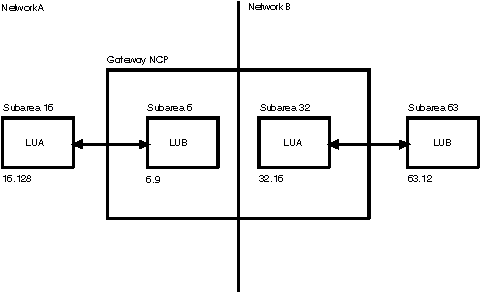 z/OS Communications Server: SNA Network Implementation Guide
z/OS Communications Server: SNA Network Implementation Guide
 z/OS Communications Server: SNA Network Implementation Guide
z/OS Communications Server: SNA Network Implementation Guide
|
Previous topic |
Next topic |
Contents |
Contact z/OS |
Library |
PDF
Address translation z/OS Communications Server: SNA Network Implementation Guide SC27-3672-01 |
|
|
A gateway NCP uses one subarea for each network that is to be connected. Thus, a gateway NCP appears to reside in more than one subarea. Associated with that subarea is a pool of element addresses that can be used for cross-network sessions. When a cross-network session is requested, the gateway NCP assigns a pair of element addresses, one in each network on either side of the gateway NCP, to the session partners. This enables the gateway NCP to create within each network a representation of the session partner in the other network. Figure 1. Address translation
 For example, Figure 1 shows two networks (networks A and B) that are connected through one gateway NCP. An LU in Network A (LUA) is in session with another LU in Network B (LUB). LUB has a subarea address of 63 and an element address of 12 in its own network. Because these addresses might not be valid in Network A, the gateway NCP has given LUB a subarea number of 6 (the subarea of the gateway NCP in Network A) and an element address of 9. As a result, LUB now has a valid address in Network A that can be used for routing session data. When an LU in Network A sends data to LUB, it is routed to subarea 6, element 9, in the gateway NCP. The gateway NCP translates this address into the address to be used for LUB in Network B. It then passes the session data over to Network B. The session data is then routed through Network B to LUB in the usual manner. Similarly, the gateway NCP has given LUA an address in Network B. Any session data destined for LUA from Network B is sent to this address. 


|
 Copyright IBM Corporation 1990, 2014 Copyright IBM Corporation 1990, 2014 |